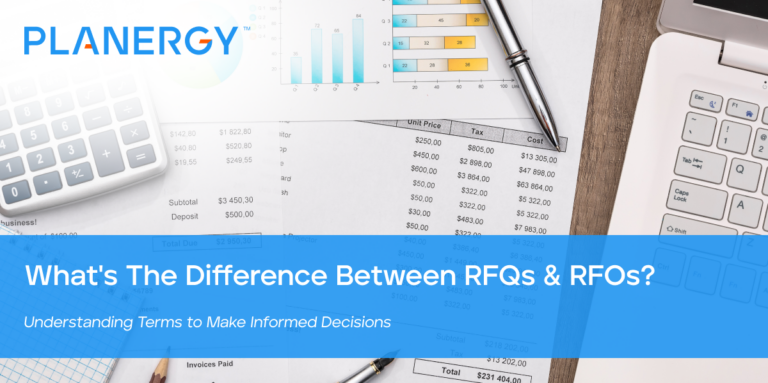In procurement, the jargon can be a little overwhelming, because so much sounds similar.
Add to this the fact that many people use terms interchangeably when those terms have different meanings, and it’s no wonder there is confusion in the procurement process.
Trading one for the other could lead to miscommunications between you and your suppliers, potentially starting relationships off on the wrong foot.
Let’s set the record straight about two of the most commonly used terms: RFQ vs. RFO.
While there isn’t a significant difference between the two terms, it’s still important to know which one to use and when.
What is an RFQ?
A Request for Quote (or Quotation) (RFQ) is a highly detailed document organizations use to solicit price quotes from suppliers for specific products or services.
It specifies the exact quantities, specifications, and terms the buyer requires.
The primary goal of an RFQ is to obtain competitive pricing from multiple vendors, making it ideal for situations where the product or service is well-defined and standardized.
For example, a manufacturing company needing a bulk order of screws with specific dimensions would issue an RFQ to compare prices from different suppliers.
An RFQ typically includes the following information:
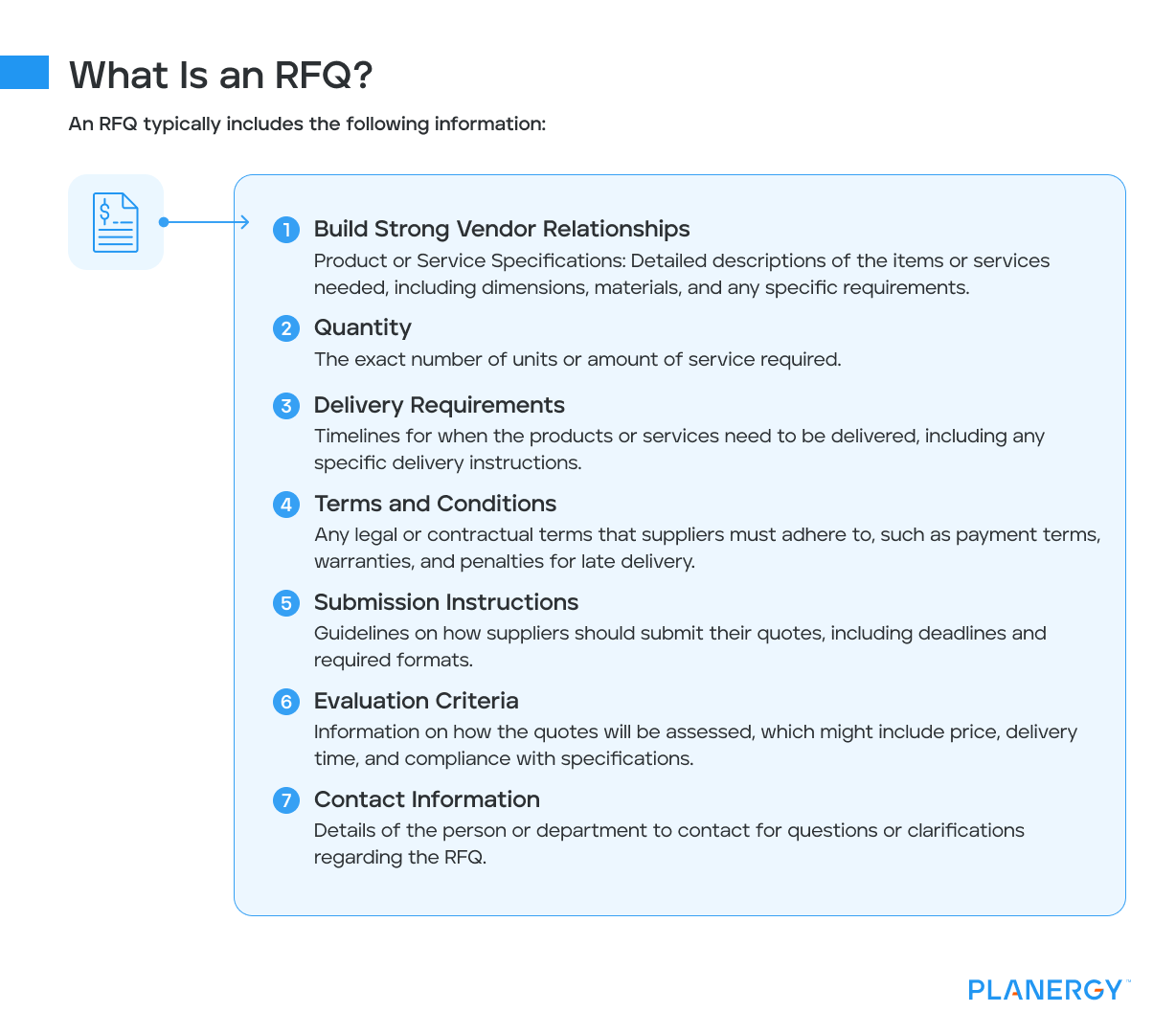
Product or Service Specifications: Detailed descriptions of the items or services needed, including dimensions, materials, and any specific requirements.
Quantity: The exact number of units or amount of service required.
Delivery Requirements: Timelines for when the products or services need to be delivered, including any specific delivery instructions.
Terms and Conditions: Any legal or contractual terms that suppliers must adhere to, such as payment terms, warranties, and penalties for late delivery.
Submission Instructions: Guidelines on how suppliers should submit their quotes, including deadlines and required formats.
Evaluation Criteria: Information on how the quotes will be assessed, which might include price, delivery time, and compliance with specifications.
Contact Information: Details of the person or department to contact for questions or clarifications regarding the RFQ.
When Do You Use an RFQ?
RFQs are best used when the procurement requirements are clear, and the organization wants to focus on cost comparison.
This process is typically employed in situations with commoditized goods where the main differentiator is price.
RFQs are typically sent when:
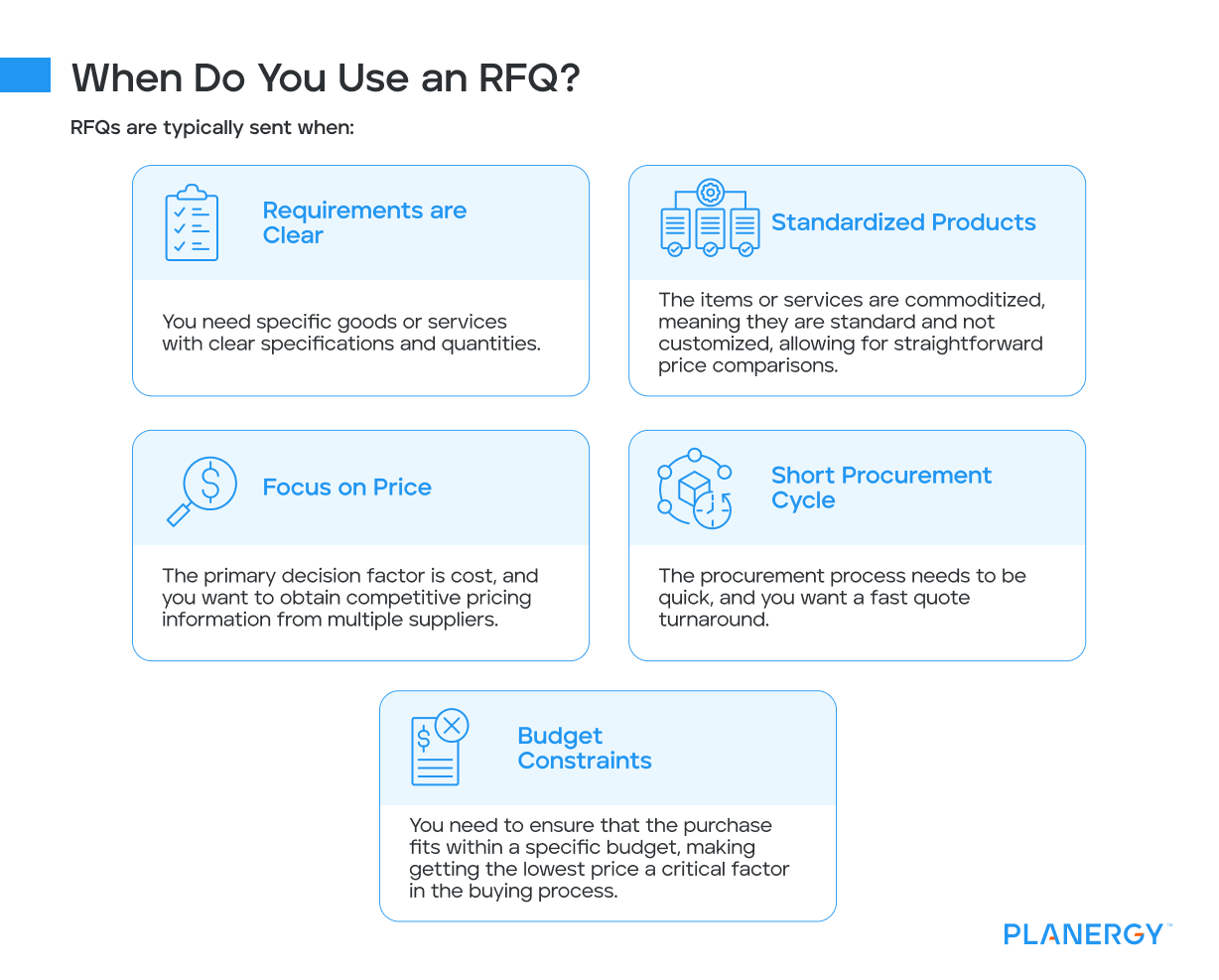
Requirements are Clear:
You need specific goods or services with clear specifications and quantities.
Standardized Products:
The items or services are commoditized, meaning they are standard and not customized, allowing for straightforward price comparisons.
Focus on Price: The primary decision factor is cost, and you want to obtain competitive pricing information from multiple suppliers.
Short Procurement Cycle: The procurement process needs to be quick, and you want a fast quote turnaround.
Budget Constraints: You need to ensure that the purchase fits within a specific budget, making getting the lowest price a critical factor in the buying process.
Using RFQs in these scenarios helps streamline the procurement process by focusing on obtaining the best price for clearly defined needs.
By obtaining quotes, procurement teams can make informed decisions based on budgetary constraints and negotiate better terms with suppliers before heading into the selection process.
The timing for sending an RFQ can vary depending on the complexity of the purchase and the procurement process, but generally, it’s advisable to send an RFQ several weeks to a few months before you make a purchase.
This allows sufficient time for:
Supplier Response: Give suppliers enough time to prepare and submit their quotes, typically a week to a month.
Evaluation: Allowing your team time to review and compare the quotes received might take a few days to a couple of weeks.
Negotiation: Providing room for necessary negotiations with suppliers to refine terms or pricing.
Approval Processes: Ensuring adequate time for internal approvals or budgetary considerations.
By planning ahead, you can ensure a smooth procurement process without unnecessary delays.
Benefits of RFQ
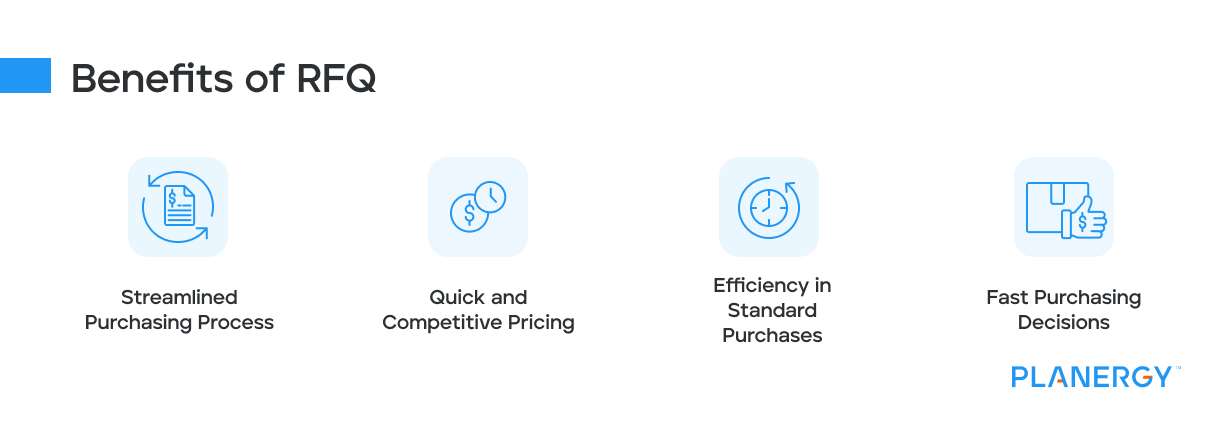
Streamlined Purchasing Process
RFQs simplify the procurement procedure by clearly defining the requirements for goods or services.
This clarity allows suppliers to provide precise and competitive pricing without extensive back-and-forth communication.
Quick and Competitive Pricing
One of the primary benefits of RFQs is the ability to obtain rapid pricing responses from multiple suppliers.
By outlining exact needs, buyers receive competitive bids, enabling them to compare prices easily and choose the most cost-effective option.
This competitive environment often results in better pricing and terms for the purchasing organization.
Efficiency in Standard Purchases
RFQs are particularly effective for procuring standard items or services with well-established specifications.
Their simplicity allows buyers to quickly solicit bids, evaluate offers, and make purchasing decisions without the complexities of more detailed procurement methods like RFOs or RFPs.
Fast Purchasing Decisions
The concise nature of RFQs facilitates faster decision-making.
With clear requirements and straightforward supplier responses, procurement teams can swiftly assess the options and award contracts.
This speed is crucial in industries where timely procurement can impact operations or project timelines.
What is an RFO?
On the other hand, a Request for Offer (RFO) is a more comprehensive solicitation document that seeks proposals from suppliers.
It goes beyond just pricing and includes other factors such as delivery timelines, warranty terms, and service commitments.
RFOs are particularly useful when the buyer is open to different approaches or solutions and the outcome is not strictly defined.
This allows suppliers to propose creative solutions that better meet the buyer’s needs.
A Request for Offer (RFO) typically includes the following information:
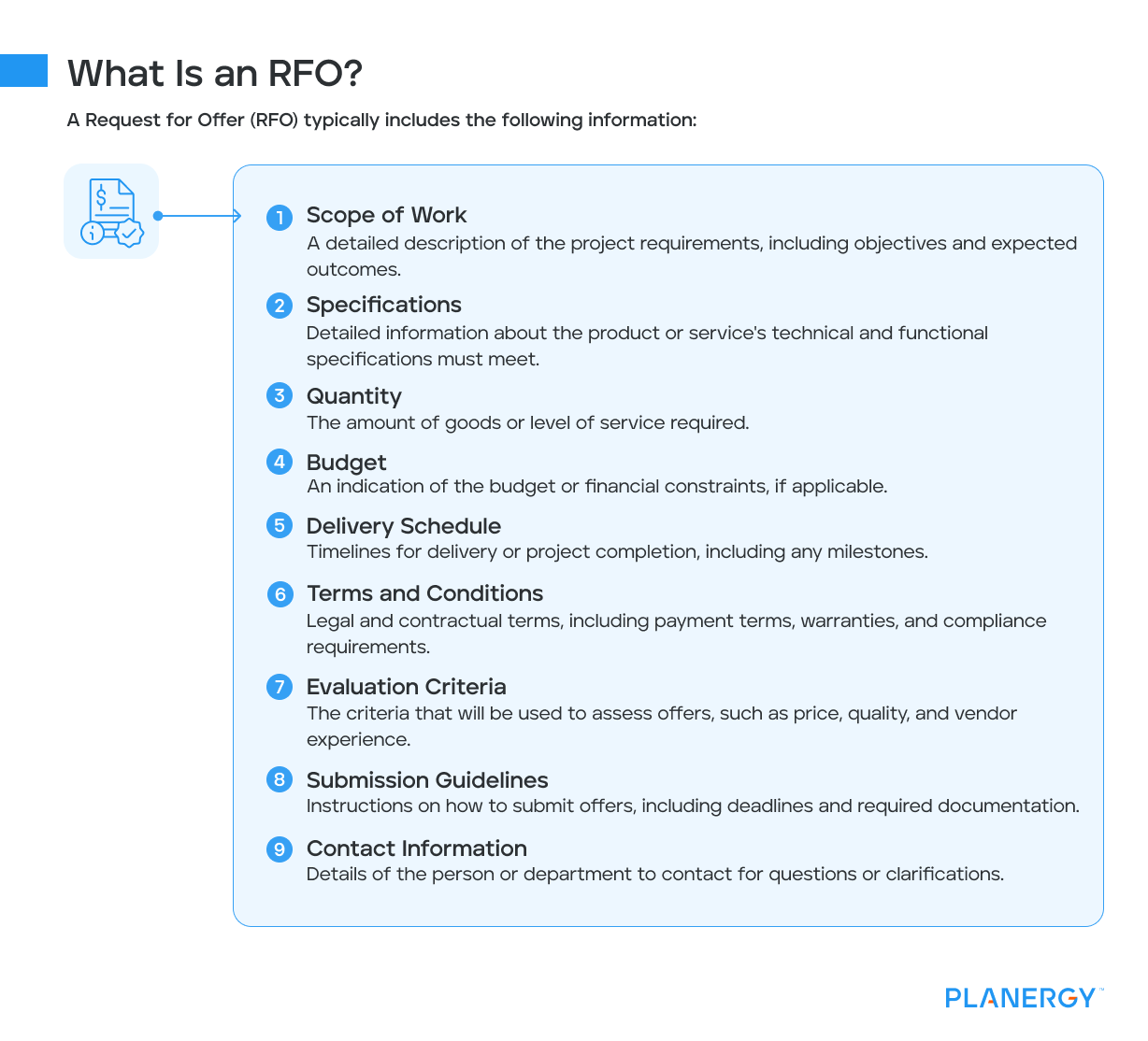
Scope of Work: A detailed description of the project requirements, including objectives and expected outcomes.
Specifications: Detailed information about the product or service’s technical and functional specifications must meet.
Quantity: The amount of goods or level of service required.
Budget: An indication of the budget or financial constraints, if applicable.
Delivery Schedule: Timelines for delivery or project completion, including any milestones.
Terms and Conditions: Legal and contractual terms, including payment terms, warranties, and compliance requirements.
Evaluation Criteria: The criteria that will be used to assess offers, such as price, quality, and vendor experience.
Submission Guidelines: Instructions on how to submit offers, including deadlines and required documentation.
Contact Information: Details of the person or department to contact for questions or clarifications.
Including these elements helps ensure suppliers provide comprehensive and competitive offers, facilitating a thorough evaluation process before vendor selection.
When Do You Use an RFO?
RFOs are suitable for complex projects or services where the buyer seeks expertise and creativity from potential suppliers.
For instance, when a company plans to overhaul its IT infrastructure, it might issue an RFO to solicit comprehensive proposals that include pricing, detailed implementation strategies, and support services.
RFOs are typically sent when:
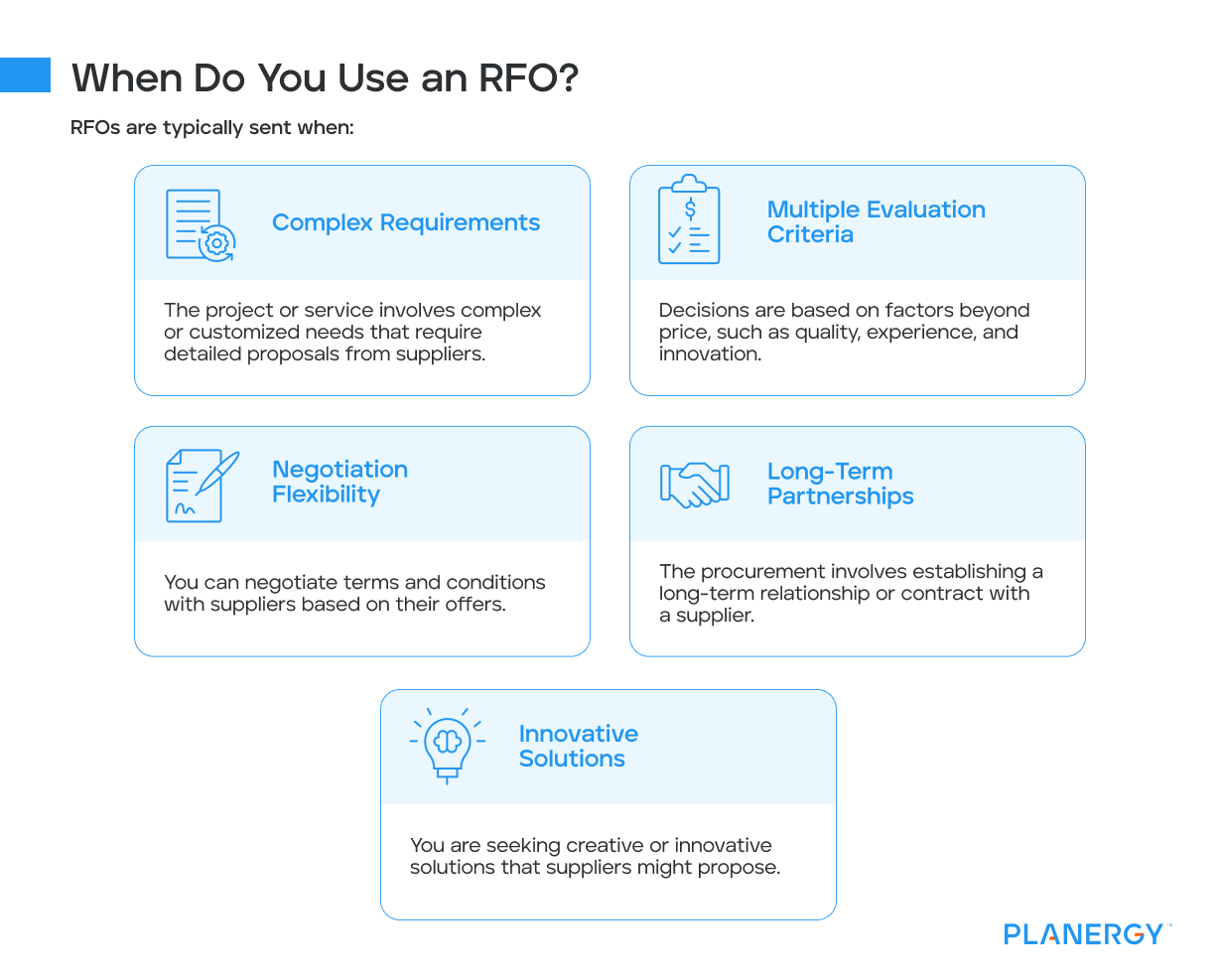
Complex Requirements: The project or service involves complex or customized needs that require detailed proposals from suppliers.
Multiple Evaluation Criteria: Decisions are based on factors beyond price, such as quality, experience, and innovation.
Negotiation Flexibility: You can negotiate terms and conditions with suppliers based on their offers.
Long-Term Partnerships: The procurement involves establishing a long-term relationship or contract with a supplier.
Innovative Solutions: You are seeking creative or innovative solutions that suppliers might propose.
Sending an RFO is ideal when you need comprehensive proposals for a more nuanced evaluation and negotiation process.
Due to the complexity and detail involved, sending an RFO typically requires more lead time than an RFQ.
It’s advisable to send an RFO several months before you plan to make a purchase.
This timeframe allows for:
Proposal Preparation: Giving suppliers ample time to develop detailed and comprehensive offers, which might take several weeks to a few months.
Evaluation Process: Allowing your team sufficient time to thoroughly review and compare the proposals, which can take a few weeks.
Negotiations: Providing room for negotiations with suppliers to refine proposals and terms, which might require additional time.
Internal Approvals: Ensuring adequate time for internal approvals or decision-making processes.
By planning well in advance, you can ensure a thorough and effective procurement process and minimize the risk of delays.
Benefits of RFOs
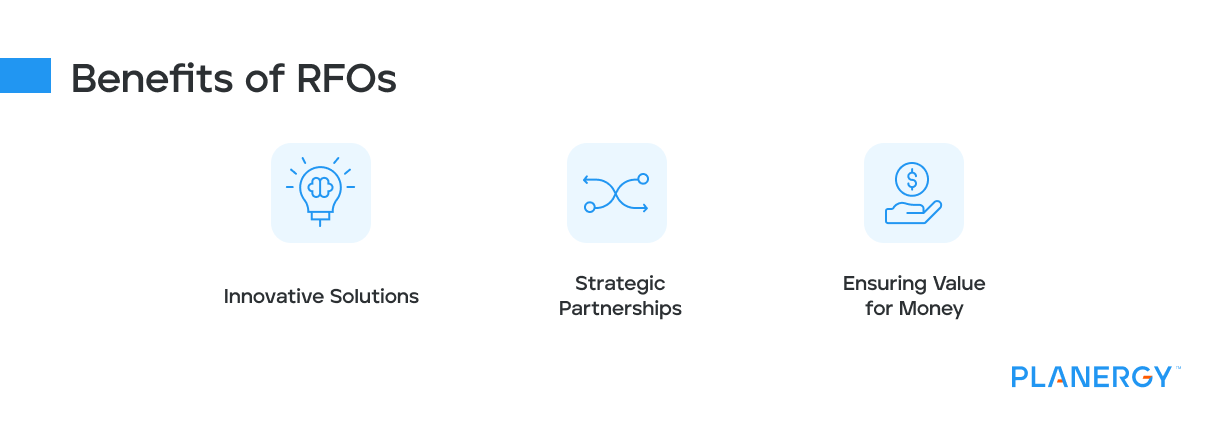
Innovative Solutions
RFOs create an environment where suppliers are encouraged to think creatively and propose innovative solutions.
By outlining complex requirements and inviting detailed offers, purchasers open the door to unique approaches and advanced technologies that might not emerge in traditional bidding processes.
Strategic Partnerships
One of the standout benefits of RFOs is their potential to foster strategic partnerships.
Because RFOs often involve more detailed and customized proposals, they allow buyers to engage with suppliers on a deeper level, facilitating long-term relationships.
This partnership approach can lead to improved collaboration, better alignment on goals, and enhanced supplier performance over time.
Ensuring Value for Money
RFOs are designed to solicit comprehensive proposals that encompass not just pricing, but also quality, service, and innovation.
This holistic view enables purchasers to evaluate offers based on overall value rather than cost alone, ensuring that the selected solution delivers maximum benefit for the investment.
Key Differences Between RFQs and RFOs
The primary difference between RFQs and RFOs lies in their scope and purpose.
RFQs are used for straightforward price comparisons of predefined products or services, while RFOs allow for more detailed proposals that consider a broader range of factors beyond cost.
RFQs focus on the “what,” specifying exactly what is needed, whereas RFOs consider the “how,” inviting suppliers to suggest methods or products that meet the buyer’s objectives.
RFQs and RFOs in the Broader Context of Procurement Documents
Within the procurement process, RFQs and RFOs are part of a larger ecosystem that includes Request for Information (RFIs), Request for Tender (RFTs), and Request for Proposal (RFPs).
Learn the differences, and you’ll know when to use what based on your procurement methods.
RFIs are used to gather general information from potential suppliers when the organization is in the early stages of a project and needs to understand market and supplier capabilities.
RFTs, similar to RFOs, are used to invite suppliers to bid on a specific project but often include more stringent compliance and legal requirements.
The competitive bidding process takes time and requires due diligence on all the responses, but it gives you a broader range of providers to choose from.
RFPs are ideal for projects where the solution is not straightforward and the organization is open to exploring different ways of achieving its goals.
For example, a company looking to implement a new customer relationship management system might issue an RFP to gather detailed proposals from potential vendors, assessing them based on criteria such as approach, technology, support, and costs.
Understanding the distinct roles of RFQs and RFOs can significantly enhance procurement strategies.
By using these documents effectively, organizations can ensure they are selecting the most suitable suppliers based on their specific needs.
Streamlining Procurement with PLANERGY
Navigating these various procurement documents (and their acronyms!) can be complex, but PLANERGY offers a streamlined solution to assist with vendor management and spend data.
A clear understanding of RFQs, RFOs, and RFPs, and their application in strategic sourcing, empowers organizations to optimize their procurement processes.
By leveraging tools like PLANERGY, businesses can enhance efficiency, foster supplier relationships, and ultimately drive better procurement outcomes.

